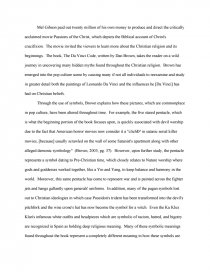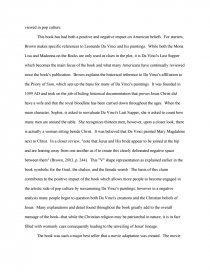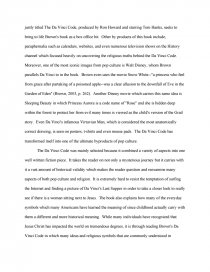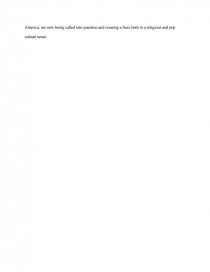Davince Code Pop Culture
Essay by 24 • March 2, 2011 • 1,104 Words (5 Pages) • 1,489 Views
Mel Gibson paid out twenty million of his own money to produce and direct the critically acclaimed movie Passions of the Christ, which depicts the Biblical account of Christ's crucifixion. The movie invited the viewers to learn more about the Christian religion and its beginnings. The book, The Da Vinci Code, written by Dan Brown, takes the reader on a wild journey in uncovering many hidden myths found throughout the Christian religion. Brown has emerged into the pop culture scene by causing many if not all individuals to reexamine and study in greater detail both the paintings of Leonardo Da Vinci and the influences he [Da Vinci] has had on Christian beliefs.
Through the use of symbols, Brown explains how these pictures, which are commonplace in pop culture, have been altered throughout time. For example, the five stared pentacle, which is what the beginning portion of the book focuses upon, is quickly associated with devil worship due to the fact that American horror movies now consider it a "clichй in satanic serial killer movies, [because] usually scrawled on the wall of some Satanist's apartment along with other alleged demonic symbology" (Brown, 2003, pg. 37). However, upon further study, the pentacle represents a symbol dating to Pre-Christian time, which closely relates to Nature worship where gods and goddesses worked together, like a Yin and Yang, to keep balance and harmony in the world. Moreover, this same pentacle has come to represent war and is painted across the fighter jets and hangs gallantly upon generals' uniforms. In addition, many of the pagan symbols lost out to Christian ideologies in which case Poseidon's trident has been transformed into the devil's pitchfork and the wise crone's hat has now become the symbol for a witch. Even the Ku Klux Klan's infamous white outfits and headpieces which are symbolic of racism, hatred, and bigotry are recognized in Spain as holding deep religious meaning. Many of these symbolic meanings found throughout the book represent a completely different meaning in how these symbols are viewed in pop culture.
This book has had both a positive and negative impact on American beliefs. For starters, Brown makes specific references to Leonardo Da Vinci and his paintings. While both the Mona Lisa and Madonna on the Rocks are only used as clues in the plot, it is Da Vinci's Last Supper which becomes the main focus of the book and what many Americans have continually reviewed since the book's publication. Brown explains the historical reference to Da Vinci's affiliation to the Priory of Sion, which sets up the basis for many of Da Vinci's paintings. It was founded in 1099 AD and took on the job of hiding historical documentation that proves Jesus Christ did have a wife and that the royal bloodline has been carried down throughout the ages. When the main character, Sophie, is asked to reevaluate Da Vinci's Last Supper, she is asked to count how many men are around the table. She recognizes thirteen men; however, upon a closer look, there is actually a woman sitting beside Christ. It was believed that Da Vinci painted Mary Magdalene next to Christ. In a closer review, "note that Jesus and His bride appear to be joined at the hip and are leaning away from one another as if to create this clearly delineated negative space between them" (Brown, 2003, p. 244). This "V" shape representation as explained earlier in the book symbolic for the Grail, the chalice, and the female womb. The basis of this claim contributes to the positive impact of the book which allows more people to become engaged in the artistic side of pop culture by reexamining Da Vinci's paintings; however in a negative analysis many people begin to question both Da Vinci's creations and the Christian beliefs of Jesus. Many explanations
...
...



